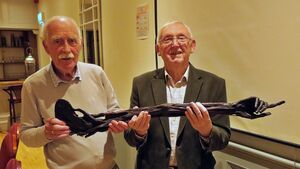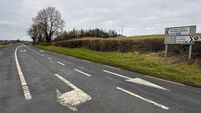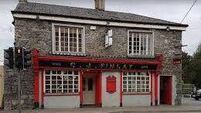Boxer with Kildare connections remembered at fascinating talk

Larry Breen and Ger McCarthy of Naas Local History Group with Dan Donnelly's mummified right arm.
One of Dublin's most famous boxers is all but forgotten in his native city, according Larry Breen of the Naas Local History Group. He was speaking on the life of the pugilist he described as "Ireland's champion when the country badly needed one."
Those present at the talk in the Town House Hotel heard Larry detail the short life of Dan Donnelly, who died suddenly at the age of 32. Much of the presentation centred around the Kildare connections of the pugilist, including the two bare-knuckle fights at the hollow on the Curragh that now bears his name.
Donnelly was trained by Robert Barclay Alderdice at Calverstown under the direction of Capt William Kelly of Maddenstown House.
"He wasn't a very disciplined fighter, though," Larry Breen said. "He preferred going to the local taverns than turning up for training." Nevertheless, Donnelly's Curragh fights against English opponents Tom Hall and George Cooper, in 1814 and 1815 respectively, reportedly attracted tens of thousands of spectators, with large sums of betting money changing hands.
Larry described the adulation of the mainly Dublin supporters after his fight against Cooper, which resulted in him being set up as a publican in Capel Street in his native city. He subsequently operated public houses in Poolbeg Street and The Coombe, but his lack of business acumen and a tendency to drink the profits with his customers left him in debt.
"He toured England on exhibition sparring bouts to earn money, during which he was purportedly knighted by the Prince Regent, later King George IV," said Larry.
He noted that it was the prince's extravagant lifestyle which gave the name to the Regency era that facilitated Donnelly's weaknesses for alcohol and women.
"When his wife heard that he had contracted venereal disease, she came to England to keep an eye on him, and after winning a prize fight against Tom Oliver he came back to Dublin, where he was treated as a hero and paraded on a white horse through the city."
Donnelly's final business venture was a pub in Pill Lane, where he died. "An event brought on by his lifestyle," Larry suggested.
Buried in Kilmainham after a funeral procession that drew huge crowds, his grave was targeted by robbers and his body sold to "a notorious surgeon named Hall" before his supporters forced the medic to hand it back.
This was minus the fighter's right arm, which subsequently became a teaching exhibit at a university in Scotland, and later went through ownership by a variety of colourful business people in London and Northern Ireland.
The arm finally became a popular attraction in Kilcullen's Hideout museum pub, from the early 1950s for more than 40 years. Between 2006–2010 the arm was exhibited in New York and Boston, and in Omagh, Co Tyrone, Croke Park, Dublin, and the University of Limerick as part of a Fighting Irishmen exhibition put together by New York-based realtor Jim Houlihan. Courtesy of the Byrne family in Kilcullen, the arm was made available for the Naas talk.
Though he was inducted into the Boxing Hall of Fame in 2008, Larry Breen said that today Dan Donnelly is largely forgotten in his native city, with no monument to him.
"Even a plaque on a government building erected on the site of his Pill Lane pub has now disappeared," he said. "It is only the Kildare connections that have kept his name and exploits alive."





